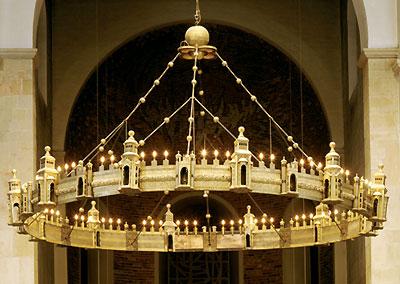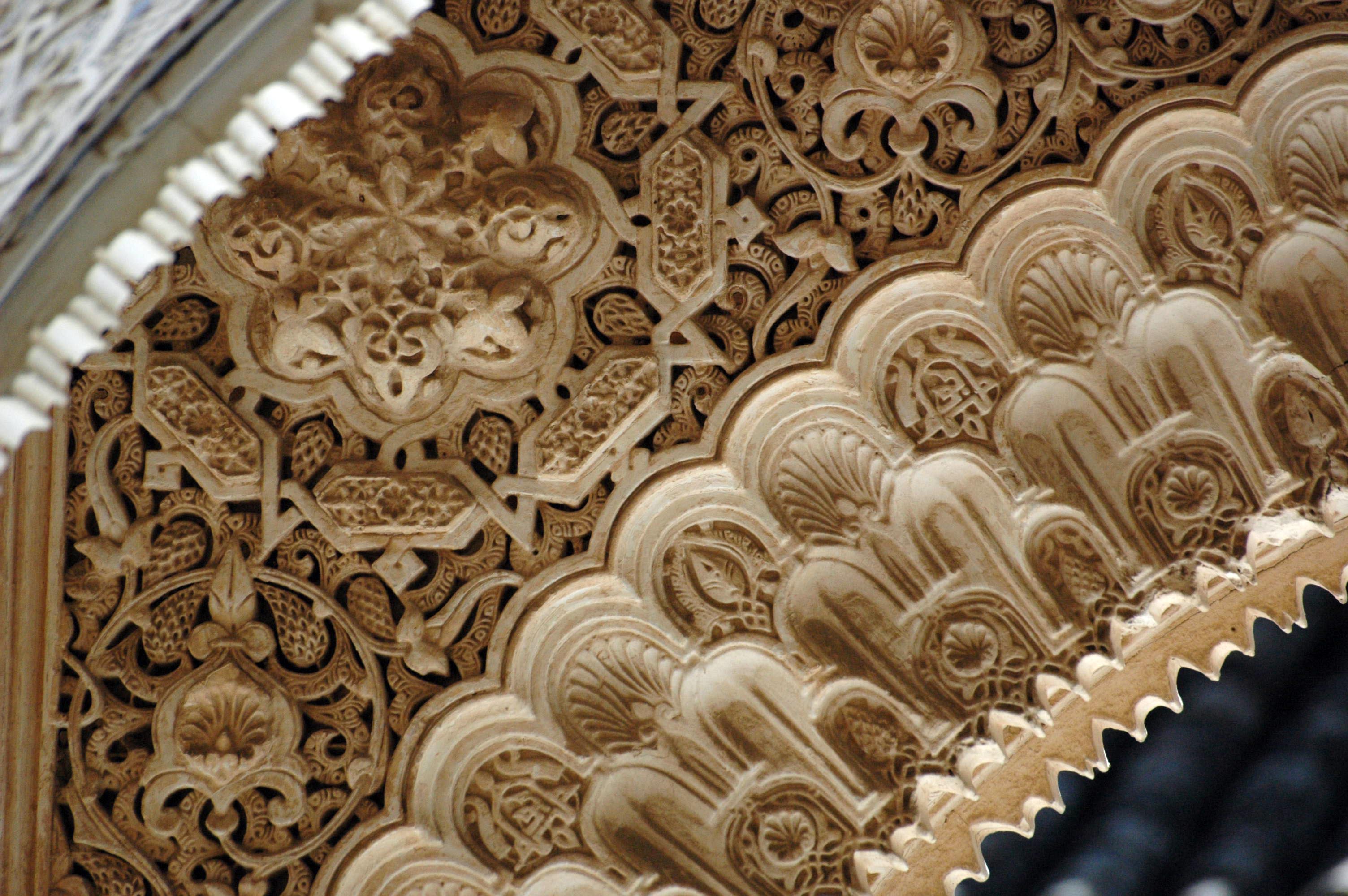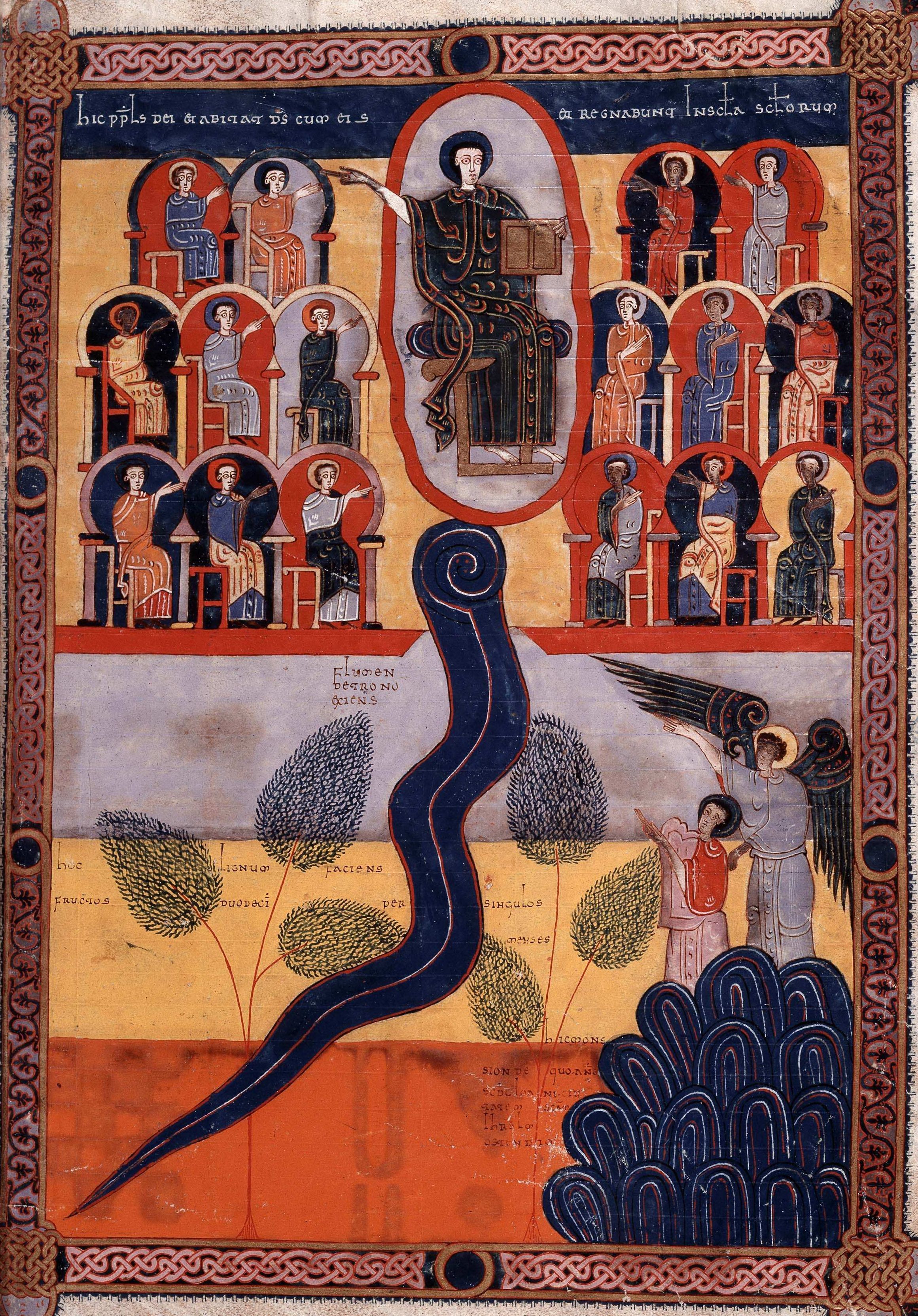|
Hezilo Chandelier
The Hezilo chandelier (german: Heziloleuchter) is an 11th-century Romanesque wheel chandelier. It is part of the treasures of the Hildesheim Cathedral in Hildesheim, Germany, which has been a UNESCO World Cultural Heritage site since 1985. The chandelier was most likely commissioned by Bishop Hezilo of Hildesheim, who rebuilt the cathedral after a fire. He probably also influenced the program of imagery and inscriptions. It is the largest of four extant wheel chandeliers of the period; the others surviving examples are the Azelin chandelier (also in Hildesheim), the Barbarossa chandelier in the Aachen Cathedral, and the Hartwig chandelier in the Abbey of Comburg. During the restoration of the cathedral (from 2010 to 2014), the chandelier was installed in St. Godehard, a basilica since 1963 and the temporary bishop's seat. After the restoration of the cathedral, reopened on 15 August 2014, it was returned to its original location in the cathedral's nave. Description The H ... [...More Info...] [...Related Items...] OR: [Wikipedia] [Google] [Baidu] |
Hildesheim Cathedral
Hildesheim Cathedral (German: '), officially the Cathedral of the Assumption of Mary (German: ''Hohe Domkirche St. Mariä Himmelfahrt'') or simply St. Mary's Cathedral (German: ''Mariendom''), is a medieval Roman Catholic cathedral in the city centre of Hildesheim, Germany, that serves as the seat of the Diocese of Hildesheim. The cathedral has been on the UNESCO World Cultural Heritage list since 1985, together with the nearby St. Michael's Church because of its unique art and outstanding Romanesque architecture. The cathedral church was built between 1010 and 1020 in the Romanesque style. It follows a symmetrical plan with two apses, that is characteristic of Ottonian Romanesque architecture in Old Saxony. The cathedral's treasures include world-famous artworks, bronze works from the time of Bishop Bernward, Bernward Doors and Bernward Column, as well as two of the four notable Romanesque wheel chandeliers: the Hezilo chandelier and the Azelin chandelier. After renovation ... [...More Info...] [...Related Items...] OR: [Wikipedia] [Google] [Baidu] |
Apostles In The New Testament
In Christian theology and ecclesiology, the apostles, particularly the Twelve Apostles (also known as the Twelve Disciples or simply the Twelve), were the primary disciples of Jesus according to the New Testament. During the life and ministry of Jesus in the 1st century AD, the apostles were his closest followers and became the primary teachers of the gospel message of Jesus. There is also an Eastern Christian tradition derived from the Gospel of Luke of there having been as many as seventy apostles during the time of Jesus' ministry. The commissioning of the Twelve Apostles during the ministry of Jesus is described in the Synoptic Gospels. After his resurrection, Jesus sent eleven of them (as Judas Iscariot by then had died) by the Great Commission to spread his teachings to all nations. This event has been called the dispersion of the Apostles. In the Pauline epistles, Paul, although not one of the original twelve, described himself as an apostle, saying he was cal ... [...More Info...] [...Related Items...] OR: [Wikipedia] [Google] [Baidu] |
Second World War
World War II or the Second World War, often abbreviated as WWII or WW2, was a world war that lasted from 1939 to 1945. It involved the vast majority of the world's countries—including all of the great powers—forming two opposing military alliances: the Allies and the Axis powers. World War II was a total war that directly involved more than 100 million personnel from more than 30 countries. The major participants in the war threw their entire economic, industrial, and scientific capabilities behind the war effort, blurring the distinction between civilian and military resources. Aircraft played a major role in the conflict, enabling the strategic bombing of population centres and deploying the only two nuclear weapons ever used in war. World War II was by far the deadliest conflict in human history; it resulted in 70 to 85 million fatalities, mostly among civilians. Tens of millions died due to genocides (including the Holocaust), starvat ... [...More Info...] [...Related Items...] OR: [Wikipedia] [Google] [Baidu] |
Hildesheim St
Hildesheim (; nds, Hilmessen, Hilmssen; la, Hildesia) is a city in Lower Saxony, Germany with 101,693 inhabitants. It is in the district of Hildesheim, about southeast of Hanover on the banks of the Innerste River, a small tributary of the Leine River. The Holy Roman Emperor Louis the Pious founded the Bishopric of Hildesheim in 815 and created the first settlement with a chapel on the so called ''Domhügel''. Hildesheim is situated on autobahn route 7, and hence is at the connection point of the North (Hamburg and beyond) with the South of Europe. With the Hildesheim Cathedral and the St. Michael's Church, Hildesheim became a UNESCO World Heritage Site in 1985. In 2015 the city and the diocese celebrated their 1200th anniversary. History Early years According to tradition, the city was named after its notorious founder ''Hildwin.'' The city is one of the oldest cities in Northern Germany, became the seat of the Bishopric of Hildesheim in 815 and may have been ... [...More Info...] [...Related Items...] OR: [Wikipedia] [Google] [Baidu] |
Islamic Art
Islamic art is a part of Islamic culture and encompasses the visual arts produced since the 7th century CE by people who lived within territories inhabited or ruled by Muslim populations. Referring to characteristic traditions across a wide range of lands, periods, and genres, Islamic art is a concept used first by Western art historians since the late 19th century. Public Islamic art is traditionally non- representational, except for the widespread use of plant forms, usually in varieties of the spiralling arabesque. These are often combined with Islamic calligraphy, geometric patterns in styles that are typically found in a wide variety of media, from small objects in ceramic or metalwork to large decorative schemes in tiling on the outside and inside of large buildings, including mosques. Other forms of Islamic art include Islamic miniature painting, artefacts like Islamic glass or pottery, and textile arts, such as carpets and embroidery. The early developments of Isla ... [...More Info...] [...Related Items...] OR: [Wikipedia] [Google] [Baidu] |
Golgotha
Calvary ( la, Calvariae or ) or Golgotha ( grc-gre, Γολγοθᾶ, ''Golgothâ'') was a site immediately outside Jerusalem's walls where Jesus was said to have been crucified according to the canonical Gospels. Since at least the early medieval period, it has been a destination for pilgrimage. The exact location of Calvary has been traditionally associated with a place now enclosed within one of the southern chapels of the multidenominational Church of the Holy Sepulchre, a site said to have been recognized by the Roman empress Helena, mother of Constantine the Great, during her visit to the Holy Land in 325. Other locations have been suggested: in the 19th century, Protestant scholars proposed a different location near the Garden Tomb on Green Hill (now "Skull Hill") about north of the traditional site and historian Joan Taylor has more recently proposed a location about to its south-southeast. Biblical references and names The English names Calvary and Golgotha ... [...More Info...] [...Related Items...] OR: [Wikipedia] [Google] [Baidu] |
Church Of The Holy Sepulchre
The Church of the Holy Sepulchre, hy, Սուրբ Հարության տաճար, la, Ecclesia Sancti Sepulchri, am, የቅዱስ መቃብር ቤተክርስቲያን, he, כנסיית הקבר, ar, كنيسة القيامة is a church in the Christian Quarter of the Old City of Jerusalem. According to traditions dating back to the 4th century, it contains the two holiest sites in Christianity: the site where Jesus was crucified, at a place known as Calvary or Golgotha, and Jesus's empty tomb, which is where he was buried and resurrected. Each time the church was rebuilt, some of the antiquities from the preceding structure were used in the newer renovation. The tomb itself is enclosed by a 19th-century shrine called the Aedicule. The Status Quo, an understanding between religious communities dating to 1757, applies to the site. Within the church proper are the last four stations of the Cross of the Via Dolorosa, representing the final episodes of the Passion of ... [...More Info...] [...Related Items...] OR: [Wikipedia] [Google] [Baidu] |
New Jerusalem
In the Book of Ezekiel in the Hebrew Bible, New Jerusalem (, ''YHWH šāmmā'', YHWH sthere") is Ezekiel's prophetic vision of a city centered on the rebuilt Holy Temple, the Third Temple, to be established in Jerusalem, which would be the capital of the Messianic Kingdom, the meeting place of the twelve tribes of Israel, during the Messianic era. The prophecy is recorded by Ezekiel as having been received on Yom Kippur of the year 3372 of the Hebrew calendar. In the Book of Revelation in the New Testament, the city is also called the Heavenly Jerusalem, as well as being called Zion in other books of the Christian Bible. Judaism and origin In Jewish mysticism, there are two Gardens of Eden and two Promised Lands: the heavenly invisible one and the earthly visible one that is a copy of the heavenly invisible one. Heaven in Jewish mysticism includes a heavenly Promised land - including Jerusalem, the temple, and the ark of the covenant - and a heavenly Garden of Eden - i ... [...More Info...] [...Related Items...] OR: [Wikipedia] [Google] [Baidu] |
Monumenta Germaniae Historica
The ''Monumenta Germaniae Historica'' (''MGH'') is a comprehensive series of carefully edited and published primary sources, both chronicle and archival, for the study of Northwestern and Central European history from the end of the Roman Empire to 1500. Despite the name, the series covers important sources for the history of many countries besides Germany, since the Society for the Publication of Sources on Germanic Affairs of the Middle Ages has included documents from many other areas subjected to the influence of Germanic tribes or rulers (Britain, Czech lands, Poland, Austria, France, Low Countries, Italy, Spain, etc.). The editor from 1826 until 1874 was Georg Heinrich Pertz (1795–1876); in 1875 he was succeeded by Georg Waitz (1813–1886). History The MGH was founded in Hanover as a private text publication society by the Prussian reformer Heinrich Friedrich Karl Freiherr vom Stein in 1819. The first volume appeared in 1826. The editor from 1826 until 1874 was Geo ... [...More Info...] [...Related Items...] OR: [Wikipedia] [Google] [Baidu] |
Azelin
Azelin (before 1000 – 8 March 1054) was Bishop of Hildesheim from 1044 until 1054. Azelin's origin is not known. He was appointed Bishop of Hildesheim by Emperor Henry III, succeeding Thietmar. During his tenure, the cathedral built by Altfrid was destroyed by a fire on 23 March 1046, along with works of art and documents. Azelin's plans to build a new cathedral were not successful. The wheel chandelier known by his name as the Azelin chandelier was possibly donated by Thietmar. He died in Hildesheim and was succeeded by Hezilo. Literature * Adolf Bertram Adolf Bertram (14 March 1859 – 6 July 1945) was archbishop of Breslau (now Wrocław, Poland) and a cardinal of the Roman Catholic Church. Early life Adolf Bertram was born in Hildesheim, Royal Prussian Province of Hanover (now Lower Saxony), ...: ''Geschichte des Bisthums Hildesheim''. Lax, Hildesheim u. a. 1899–1925, vol. 1, pp. 100–107. References 11th-century German Roman Catholic bishops R ... [...More Info...] [...Related Items...] OR: [Wikipedia] [Google] [Baidu] |
Vita Bernwardi
Thangmar (Thankmar) (b. about the middle of the tenth century; d. probably at Hildesheim after 1022) was a German chronicler. Life His first appearance in history is as the head of the cathedral school at Hildesheim; at a later date he became dean of the cathedral, and being at the same time notary and librarian his position was a very important one. Thangmar was distinguished both as a scholar and a statesman; he taught several bishops including Bernward of Hildesheim, Meinwerk of Paderborn, and Benno of Meissen, as well as the Emperor Henry II. He exercised great influence over Bernward, Archbishop of Hildesheim, and a large part of the affairs under episcopal control were directed by him. In 1000 he accompanied Bernward to Rome, and was sent several times to the imperial court as the representative of the bishop to settle important matters, being highly esteemed by Emperor Otto III. Works After the death of Bernward in 1022 he wrote an account of the active and varied life o ... [...More Info...] [...Related Items...] OR: [Wikipedia] [Google] [Baidu] |
Altfrid
Saint Altfrid (or Altfrid of Hildesheim) (died 15 August 874) was a leading figure in Germany in the ninth century. A Benedictine monk, he became Bishop of Hildesheim, and founded Essen Abbey. He was also a close royal adviser to the East Frankish King Louis the German. He is a Roman Catholic saint. His feast day is celebrated on 15 August, the feast of the Assumption of the Virgin Mary, but also in Essen and Hildesheim on 16 August. Life There is no contemporary biography of Altfrid. He is first mentioned by name on 3 October 852, when he took part in a council in Mainz as Bishop of Hildesheim. According to the ''Hildesheim Chronicle'' Altfrid died "rich in days" in 874, from which a year of birth of around 800 is assumed. He owned land in the Harzvorland and in central Essen (''Asnithi''), which may have been inherited from his family, and it seems likely that he belonged to the Saxon nobility, and may have been connected to the Imperial family of the Liudolfings, who, h ... [...More Info...] [...Related Items...] OR: [Wikipedia] [Google] [Baidu] |






.jpg)


